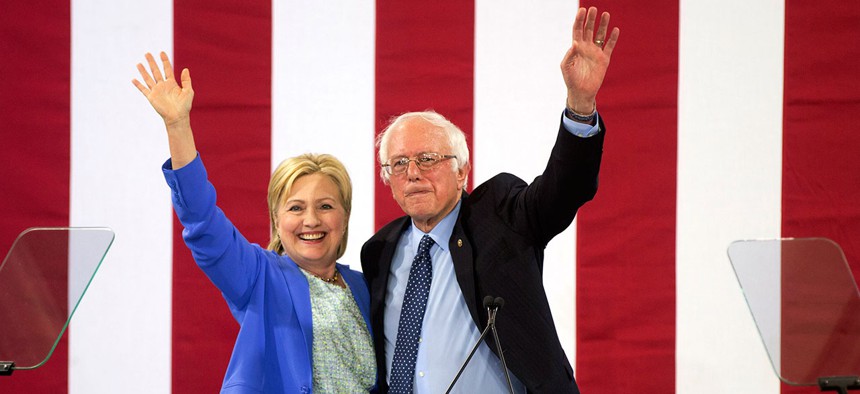
Jim Cole/AP
The End of a Political Revolution
By endorsing Hillary Clinton, Bernie Sanders signals that his presidential run is over.
Bernie Sanders’s fight for the White House has reached its end. He appeared side-by-side with his long-time rival Hillary Clinton on Tuesday and officially endorsed her as the Democratic Party’s presidential nominee. The endorsement was proof that even Sanders can no longer ignore the reality that the Democratic race is over—and he lost.
“Secretary Clinton has won the Democratic nominating process, and I congratulate her for that,” Sanders said during a joint appearance with Clinton in New Hampshire clearly aimed at unity. That doesn’t mean, however, that he is ready to formally exit the race. According to a campaign spokesman, Sanders remains a presidential candidate and is not dropping out of the race following his endorsement of Clinton. During the speech, Sanders was quick to remind the crowd that “we have begun a political revolution … and that revolution continues.”
For now, his political revolution has come up short. From the start of his campaign, Sanders called for a fundamental transformation in American political life so that the voices of average Americans would not be drowned out by wealthy elites and the gap between the rich and poor would not be nearly so vast. Yet Democratic primary voters overwhelmingly sided with Clinton’s pragmatic incrementalism over Sanders’s enthusiastic idealism. If the senator’s dream of revolution is ever to be achieved, it won’t happen with Sanders as the next president.
Nevertheless, Sanders vastly exceeded expectations. He convened massive rallies and filled stadiums to the point of overflowing, showing that stubborn insistence can register as charisma on the campaign trail. He did the unthinkable by raising millions of dollars and running a competitive presidential campaign while shunning super PACs. His fundraising strategy alone could serve as a powerful model for future candidates.
While Sanders worked to push the Democratic Party in a progressive direction, it remains to be seen how much of an lasting impact that effort will ultimately have. At the very least, his campaign demonstrated widespread enthusiasm for populism and an intense desire to reject the political status quo, particularly among a younger generation of voters who flocked to support the senator.
It is remarkable that a self-described democratic socialist managed to get so close to the White House in a country that so ardently proclaims its adoration for free markets. Sanders did not prove that embracing socialism is a winning proposition, but he showed that the label is not politically toxic either.
More broadly, the senator challenged Americans to rethink what it means to be radical, arguing that ideas often relegated to the fringe should be considered common sense. “Health care should be a right of all people, not a privilege,” Sanders declared in a speech intended to explain his vision of Democratic socialism in November of last year. “This is not a radical idea.”
It was a highly improbable rise. When he launched his White House bid, Sanders seemed to have been overlooked by the people who should have been his natural allies. Democracy for America and MoveOn.org, progressive groups that later endorsed Sanders, spent the weeks leading up to his presidential announcement trying to draft Massachusetts Senator Elizabeth Warren to run for president.
Even Sanders publicly expressed doubt over whether he could achieve his aims. He promised to raise money through “small, individual contributions,” beforemusing aloud during a press conference “whether it is possible for any candidate, who is not a billionaire, or who is not beholden to the billionaire class, to be able to run successful campaigns.” Later in the campaign, Sanders told supporters that when he entered the race, his “greatest fear was that if we did not do well that it would be a setback not just for me, but for the ideas driving our campaign.”
Despite his concerns, Sanders succeeded in bringing attention to a progressive agenda during his presidential run, and Clinton ultimately embraced some of the ideas he championed. Following Sanders’s lead, Clinton came out in opposition to the Trans-Pacific Partnership, an international trade deal supported by President Obama, and the Keystone XL oil sands pipeline. In the past week, Clinton embraced ideas that Sanders has championed to expand access to health care and make higher education more affordable.
The senator also won concessions in the Democratic Party platform, a non-binding statement of priorities for the party. In the platform fight, Sanders supporters secured a litany of wins, including endorsement of progressive Wall Street reforms, and support for a $15 dollar minimum wage. Showing the limits of his influence, however, Sanders failed to convince Democrats to embrace trade deal opposition in the platform. It remains to be seen how much weight the platform, or Clinton’s policy promises, will carry. But pointing to concessions undoubtedly makes it easier for Sanders to justify an endorsement of Clinton.
His presidential bid may stand as the senator’s crowing political achievement. Sanders spoke of his surprise at how many people ultimately supported his campaign during an interview with C-SPAN. He recalled “driving to the location where we were going to go give a speech, and I saw a long, long line of people," saying that he “said to the guy next to us, ‘I wonder what's going on, they got a concert or something?’” It turned out the people were there to see him. Reflecting on his campaign, Sanders said: “Energy just flowed right into me, and I was able to [talk] to many thousands of people.”
At times, the revolution threatened to turn ugly. The campaign took aim at the Democratic National Committee last December, accusing the party of placing a “thumb on the scales in support of Hillary Clinton’s campaign.” Sandersdenounced DNC Chair Debbie Wasserman Schultz, and even endorsed her primary challenger. By choosing to remain in the race after it became clear he had no realistic path to the White House, Sanders also had to watch high-profile allies defect to Team Clinton, and see his supporters increasingly side with the Democratic Party’s presumptive nominee.
Sanders has attempted to lay the groundwork for a lasting political movement, but there too the future is uncertain. He endorsed an array of congressional candidates as well as contenders vying for seats in state legislatures, though that effort has already encountered setbacks. His presidential run has given rise to a grassroots army of supporters looking for ways to carry on the fight. The question now is: how much success will Sanders and his followers have in building a movement that outlasts the campaign?
Sanders has made clear he does not want to see Donald Trump in the White House. “The major task that we face in the next five months is to make certain that Donald Trump is defeated and defeated badly,” Sanders told supporters in June. Denouncing Trump as a divisive candidate, Sanders warned: “After centuries of racism, sexism, and discrimination of all forms in our country, we do not need a major party candidate who makes bigotry the cornerstone of his campaign.”
Whatever Sanders turns his attention to after the presidential election, the effort may be more difficult, in part, because it is likely to provide less visibility than his presidential run. The spotlight of a national election will fade away, and Sanders may find it comparatively dull and disappointing to return to the corridors of Capitol Hill. He will return with an elevated political profile, if nothing else. Whether he can translate that influence into lasting political and legislative gains is another matter.







